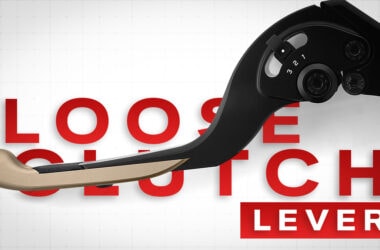Table of Contents Show
Motorcycle braking system plays a crucial part in a rider’s safety and riding experience. Brake pads are the ones that are pushed onto the discs to stop your motorcycle, proper maintenance and replacement should be done if necessary.
Motorcycle brake pads should be replaced when the grooves on the pad’s surface are not clearly visible and where the thickness of the pads is less than 2 millimeters, or you can replace them as often as every 6,000 Miles/10,000 Kilometers for good safety measures.
Changing or replacing brake pads is as necessary as maintaining your motorcycle’s discs/rotor, calipers, caliper pistons, and brake fluid.
If you feel your motorcycle is losing its braking power significantly it’s time to replace or check the brake pad condition.
There are different types of brake pads available in the market like Ceramic/Sintered brake pads, organic brake pads, and semi-metallic brake pads.
Some brake pads are made from a combination of metal and organic compounds like glass, aramid fiber, rubber, and resin.
In this article, you will know when and how often you should replace or change your motorcycle’s brake pads ( Front & Back Brake Pads) cause there are differences between them, What are the signs of worn brake pads, how long brake pads, how long brake pads generally last and when to check them.
How Do You Know When Motorcycle Brake Pads Need Replacing?
The brake pads of the motorcycle need replacement when the surface thickness of brake pads gets below 1.5-2 millimeters due to friction caused by braking over time.
Depending on the motorcycle’s power output and the engine’s cubic capacity, the thickness of the brake pads will vary from motorcycle to motorcycle.
But as a general rule, the majority of motorcycle manufacturers recommend replacing the brake pads if the surface thickness gets worn down below 1.5-2 millimeters.
You can also inspect the grooves of the brake pad’s surface to check whether it needs replacing or not.
A sure indicator to replace the brake pad is when the groove on the pad is no longer visible.
You can do this by simply observing the brake pads with a flashlight from a better viewing angle to check if the groves are still present on the pads or not.
But some brake pads don’t have grooves on their pad surface, that’s when you can measure the surface thickness of brake pads and decide whether it needs replacement.
Motoxtasy Knowledge: Track Racing bikes which are typically higher in engine's cubic capacity and bhp motorcycles have thicker brake pads compared to street use-only motorcycles.
Keep in mind that your riding style and surrounding conditions will play a huge part in the wear and tear of your motorcycle’s brake pads. If you do hard braking pretty often then fading of the brake pads will be faster.
How Often Do Motorcycle Brakes Need To Be Replaced?
As discussed earlier brake pad changing interval will be totally dependent on multiple factors such as riding style( breaking pressure), riding conditions, and even motorcycle riding frequency too.
But for the rider’s safety, motorcycle front and rear brake pads should be replaced as often as every 6,000 Miles/10,000 Kilometers – 9,000 Miles/15,000 Kilometers if you ride regularly.
Replacing/changing the front and rare brake pads at the same time will avoid an imbalance of the wear and tear on the brake pads because it will make the rider use both brakes rather than one which is in good condition and avoid using the brakes which is in bad condition.
If you are an occasional motorcycle rider who takes out the motorcycle for a ride couple of times every few months, then your brake pads will last for a long time and do not need frequent replacements.
Some people use their front brakes a lot compared to their rear brakes or vice versa, but the wear and tear difference won’t be too drastic because no one in a sane mind would use only front or rear brakes exclusively.
How Long Do Motorcycle Brake Pads Last?
Motorcycle brake front and rear brake pads can last for a very long time, but the wear on them will be dependent on how excessively riders use their braking application.
Usually, rear brake pads last longer than front brake pads because front brakes produce 70% of braking power in the motorcycle and are under consistent use compared to rear brakes, but you can check your motorcycle’s brake pad condition every 6,000 Miles/10,000 Kilometers to see whether it needs changing or not.
Know that your riding style and how much you use your braking will determine how long the brake pads can last.
You can check the owner’s manual to check what kind and type of brake pads are compatible with your motorcycle because the horsepower and engine size of the bike matter when selecting brake pads.
Brake pads are made up of different material compounds as we discussed earlier and these compounds determine the longevity of these brake pads.
Here’s a quick way to understand the longevity of the brake pads which are available in the market.
Ceramic/sintered brake pads last longer than organic and semi-metallic brake pads, semi-metallic last longer compared to organic brake pads whereas organic brake pads offer the least longevity out of these 3 brake pad types.
You definitely don’t want brake pads that are overdue the replacement period cause the backplate of the brake pads can come into contact with the disc/rotor once the padding material of the pads is significantly worn, this can cause damage to the disc/rotor’s surface and high heat caused due to this friction will likely damage the caliper pistons too.
Top 5 Signs That Your Motorcycle’s Brake Pads Are Worn Out
Here are the common top signs you need to look out for if your motorcycle’s brake pads are worn out.
- Grinding Or Squealing Noise When Brakes Are Applied.
- The Brake Lever Feels Spongy.
- Motorcycle Will Take Longer Time To Stop.
- Worn Brake Pads Thickness Will Be Under 1.5-2 Millimeters.
- Significant Drop In Brake Fluid Levels.
1. Grinding Or Squealing Noise When Brakes Are Applied
Grinding or squealing noise when braking can come once a significant amount of padding ( friction ) material is worn leaving behind the exposed backplate of the brake pads.
This backplate can come into contact with the brake discs/rotor of the motorcycle causing a grinding and squealing noise.
This can damage the surface of the disc/rotor if the worn-out brake pads are not replaced.
2. The Brake Lever Will Feel Spongy & Unresponsive
Worn-out brake pads of the motorcycle will have a hard time coming into contact with the disc/rotor of the motorcycle, this can make you feel the brakes are not as responsive as they should be.
You might have the pull or press the brake lever ( front or rear brake ) harder than usual, which can also make you feel brake levers spongy and ineffective.
3. Motorcycle Will Take Longer Time To Stop
This sign is pretty obvious because a brake pad that is worn out will have a much harder time stopping the motorcycle faster and more effectively.
Worn-out brake pads do not have much padding material left, which results in the motorcycle taking longer time to stop.
Motorcycle rider safety should be the top concern and a motorcycle that has bad braking will put you at risk, so replace worn-out brake pads as soon as possible if you are experiencing this.
4. Worn Brake Pads Thickness Will Be Under 1.5-2 Millimeters
You should know that different motorcycles come with different types of brake pads and the thickness of the padding ( friction ) material will vary depending on the motorcycle’s power and engine cubic capacity and motorcycle type.
But as a general safety rule, replace the brake pads once the thickness of the padding material of the brake pads gets worn down below 1.5 to 2 millimeters.
There is likely a higher chance of the brake pad’s backplate rubbing against the disc/rotor, which will damage the rotor disc.
And a host of multiple problems like loss of braking power, and ineffective unresponsive brake response will cause the motorcycle rider’s safety.
So change or replace the brake pads once their thickness gets worn down below 1.5-2 millimeters.
5. Significant Drop In Brake Fluid Levels
Brake fluid helps the caliper pistons to push the brake pads onto the brake disc/rotor to stop the motorcycle whenever needed.
The thickness of the worn-out brake pads drops, causing the caliper piston to come out more from its cylinder to push the brake pads onto the disc/rotors.
Due to worn brake pads, caliper pistons have to move more inside its cylinder so a higher amount of brake fluid will be used causing a significant drop in motorcycle brake fluid level.
So each time you press or pull the front or rear brakes of the motorcycle brake fluid is used to pressurize and move the caliper pistons.
Why Do Motorcycle Brake Pads Need To Be Changed?
As you ride your motorcycle on regular basis, most of the time braking has to be used to navigate the road efficiently.
Over time motorcycle brake pads will get worn out which might lead to the formation of cracks in them. Ineffective braking will be the result of worn brake pads and can cause damage to the brake discs/rotor and caliper pistons.
Not changing or replacing brake pads will lead to brake failure in your motorcycle and can put you at risk, so you should replace brake pads once they are worn out.
It’s plain and simple, do timely maintenance of your motorcycle braking system to enjoy your ride safely.
Conclusion
You should replace brake pads when grooves on them are no longer clearly visible that’s a clear sign of worn-out brake pads and you can replace brake pads as often as every 6,000 Miles/10,000 Kilometers – 9,000 Miles/15,000 Kilometers for good safety measures.







